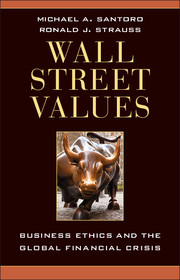Book contents
- Frontmatter
- Contents
- Preface
- Acknowledgments
- Part One Background and Theoretical Framework
- Chapter One A Financial, Governmental, and Moral Crisis
- Chapter Two Does Wall Street Have Any Responsibility to Society?
- Part Two Wall Street Business Model, Regulation, and Values in Transition
- Part Three Policy Recommendations and Sustainable Values for Wall Street in the Twenty-First Century
- Notes
- Index
Chapter One - A Financial, Governmental, and Moral Crisis
from Part One - Background and Theoretical Framework
Published online by Cambridge University Press: 05 February 2013
- Frontmatter
- Contents
- Preface
- Acknowledgments
- Part One Background and Theoretical Framework
- Chapter One A Financial, Governmental, and Moral Crisis
- Chapter Two Does Wall Street Have Any Responsibility to Society?
- Part Two Wall Street Business Model, Regulation, and Values in Transition
- Part Three Policy Recommendations and Sustainable Values for Wall Street in the Twenty-First Century
- Notes
- Index
Summary
Introduction
On Monday, September 15, 2008, Lehman Brothers, a prominent investment bank that traces its roots to 1850, declared bankruptcy and thereupon triggered a global financial crisis. Literally overnight, borrowing came to a standstill, and widely held assets could not be converted into cash. The liquidity crunch immediately crippled banks owning substantial amounts of securities linked to subprime mortgages and spread very quickly to every sector of the global economy and all types of debt securities. Unable to sell even normally safe and highly liquid investments, on Tuesday, September 16, 2008, the Primary Reserve Fund, the oldest money market fund in the United States, in an action eerily reminiscent of Depression-era bank runs, shocked the financial community by freezing customer accounts and indefinitely halting withdrawals. Ordinary consumers were thus harshly reminded that there were no safe havens for their savings in this economic storm, adding another layer of uncertainty and instability to the financial markets. Within weeks of the Lehman bankruptcy, the resulting shock to the financial system inflicted severe and long-lasting damages on the economy, throwing tens of millions of people out of work and slowing economic growth. Half a decade later, the global economy still limps along in the aftermath of the financial crisis.
The financial crisis sprang from a precipitous decline in the value of mortgage-related securities. The bursting of the mortgage bubble completely wiped out Lehman’s capital base. Other venerable Wall Street institutions including Merrill Lynch and Bear Stearns narrowly averted total collapse through hastily arranged mergers with Bank of America and JPMorgan Chase, respectively. Virtually every major financial institution had massive exposure to the mortgage market relative to its capital base, and even those banks not in danger of imminent collapse suffered staggering losses severely limiting their ability to engage in ordinary consumer lending activities and basic interbank transactions. Because of the financial sector’s centrality to capital and credit markets, the U.S. Congress authorized a $700 billion government bailout to prevent further failures and safeguard the financial system from total collapse.
- Type
- Chapter
- Information
- Wall Street ValuesBusiness Ethics and the Global Financial Crisis, pp. 3 - 26Publisher: Cambridge University PressPrint publication year: 2012
- 1
- Cited by



